Bob Haro is getting his numberplate business off the ground. Bob began producing numberplates for BMX bikes in his bedroom in 1976, the year he graduated from high school, at first for friends, then later for any racers who wanted them.
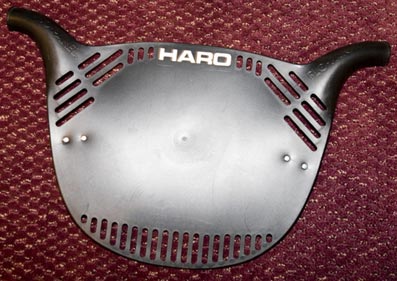
In 1978, Bob rented a 10x15-foot workspace in Torrance California, for $100 a month and moved his business out of his bedroom.
Bob Haro: My room smelled like vinyl ink. I used to put all the decals and numberplates underneath my bed.
Sales totales $40,000 in 1979.
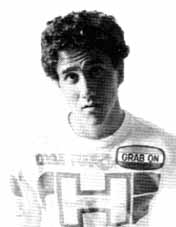
Demand for these stylish plates quickly outgrew Bob's one man capacity. Haro Designs, the first name of the company, was formed in 1980 with headquarters in Torrance, California.
PLASTIC BRAKE LEVER.
The Haro lever was the major "brake-through." It was an instant hit for the first year and a half. It was trick looking with those two finger slots and cool color combos when you mixed and matched. Hip and ahead of its time. Everyone dug on 'em, until they found out that it flexed a lot and limited stopping power.
Bob Haro: Around 1980 we started making a plastic brake lever. I met a guy who had an idea for that and we put that together and put our name on it.
Gary Haselhorst, www.vintagebmx.com, july 2006: The Lever was designed by a kid in High School. He raced local at the Azusa Calif. BMX track. I am pretty sure his name was Greg Keyes.
New Series-one: velcro fasteners, stadium numbers and brake levers. Available in red, yellow, blue, black and white.
TYPE 2 NUMBER PLATE.
Ad in BMX Plus september 1981: New type-2 number plates, velcro fasteners, panel covers, stadium numbers, brake levers.
FREESTYLE FRAME.
www.harobikes.com: In the summer of 1981, Bob Haro and fellow Haro Trick team member Bob Morales set out on a three-month tour of the United States to promote BMX Freestyle to the youth of America. They travelled in a new Dodge truck, decorated in the Haro team colors and covered almost 18,000 miles over the period. During the long days and nights on the road, Haro shared with Morales his vision and desire to create a dedicated frame and fork combination specifically for the future development of Freestyle riding. The frame would be marketed and sold as a Haro product, and on his return to California, Haro pitched the idea to his frame sponsor, Torker BMX. A deal was struck and a period of prototyping and refinement began, with Haro, Morales and a young headline maker named Eddie Fiola all testing the frame at skate parks south of Los Angeles. The finished design entered full production at the Torker facility in Fullerton, California in the summer of 1982, and would mark one of the most important moments in the history of Freestyle BMX.
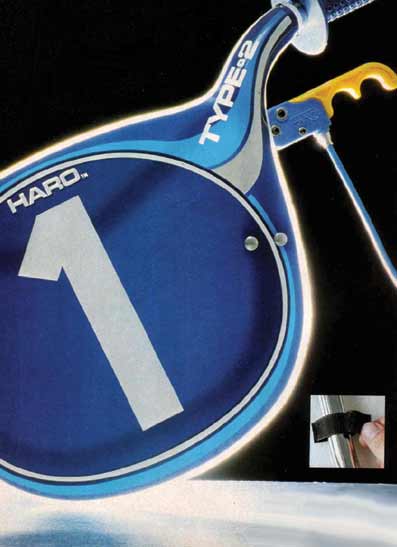
Type-2 number plate.
Bob Haro, BMX Plus! march 1982: We have a 3000 square foot building. I've got about - in full production - probably about sixteen guys that work here full time. I've got a full-time manager. Casey's full time and the office manager. Then a full-time secretary. And we're getting ready to move. We're moving in February to our new office. It'll be about a 4850 square foot building that we just bought, and we're getting offices. And I got a new guy. His name is Jim Ford. He used to work for Kryptonics. He was the guy in charge of marketing and product development. He'll be working for us, so we're moving up.
AD.
Haro ad, 1982: To be number one you have to earn it. Haro number plates were the first plates ever designed for BMX. And they've been winning ever since. That's because Haro is ahead of the competition when it comes to design, innovation, and quality construction. Just ask Greg Hill, Toby Henderson, Stu Thompson, Clint Miller, Brian Patterson, Tinker Juarez or any other member of the Haro All-Star team. See the new Series 1 and the full line of Haro BMX components at a bike shop near you. You can't buy better equipment.
FREESTYLE FRAME.
Borrowing on the design of the Torker frame, Haro introduced the first strictly made for freestyle frame in 1982.
BMX Action october 1982: Haro Freestyler frame designed by Bob Haro. The reinforced chrome-moly frame features double tube construction, heavy duty rear dropouts with a built-in coaster brake mounting slot. All chrome-moly. Haro Designs.
Bob Haro: I used to ride for Torker. They were one of my sponsors. Haro Design, as the company was called back then, was growing. We were making different things. Freestyle was a novelty back then and I thought it was time to create a Freestyle only bike, instead of a BMX racing bike used for freestyle... I basically had a Torker BMX bike and I asked them to modify it to a bike for freestyle riding. It needed thicker drop-outs, a steeper head angle and the double top tube made sense for the type of riding at that time. I had a good relationship with the guys at Torker at the time and I basically went in one day and told him I wanted to have my own frame and my own brand. I think I told them I could either do it with, or without you, and then they worked with me. We ordered really small numbers at the time because it was so novel. Torker gave me a big start, they really helped out. They had the fixtures and things like that. We bought the frames of my design from them, put our graphics on them and sold them. It was very expensive at the time because the numbers were very small but that got us started. That was the beginning.
Bike test in BMX Plus! april 1983.
HARO FREESTYLER FORK.
Ad in BMX Action november 1982: The front half of the Haro Freestyler frame set. This chrome-moly fork features one-piece heavy-duty axle dropouts.

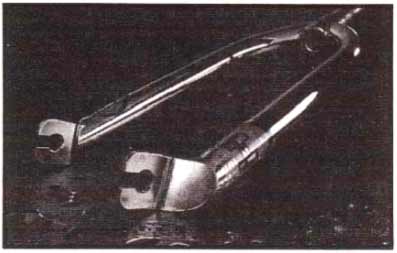
Bob Haro: The Master frame was first made in 1983 by Torker. The Master name came from when I rode and some magazine editors referred to me as "Master Bob Haro" when riding. Since I was the originator of Freestyle BMX, the Master name was born. I thought it a good name for our flagship Freestyle bike.
Haro company almost made three million $.
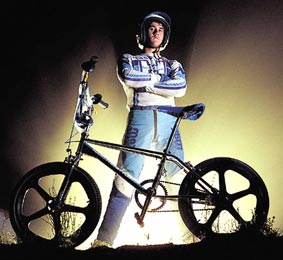
The Master frameset: This frame is designed to turn quick due to the steep 72 degree head angle. The relatively short wheelbase (35" -36") makes pivoting moves easier. The bottom bracket shell and head tube feature precision machined (not pressed on) collars for extra strength. The oversize downtube meets the headtube high to allow room for both brake clearance and a heavy duty chromoly box gusset. The rear dropouts have a unique coaster brake mounting bracket placed on top of the chainstay and a strengthening ridge along the bottom to resist flexing. Twin top tubes form a platform from behind the seat forward to the head tube and all tubing is 4130 chromoly. The fork is also 100% chromoly and is predrilled for a front brake. The Master is available in chrome or white with bold color graphics.
The Sport frameset: The Sport utilizes most of the Master's proven features. 4130 chromoly tubing, precision machined bottom bracket shell and head tube, identical forks, dropouts, and reinforcing gusset. The Sport's wheelbase is longer (36" -37") for improved tracking and stability at higher speeds. (Steering is not as quick as the Master.) The Sport features a unique two into one top tube design that provides a slightly shorter platform area than the Master.
Rich Sigur, www.notfreestylin.com: The 4130 chromoly frame (a big deal back then) was great for what it was designed for: small ramp and flatland. But my style of riding was primarily ramps and skateparks, so the early Master did not suit me so well. The shorter wheelbase was not as stable in the air. I discovered this fact one afternoon while practicing on my back yard quarter pipe. "Oh @#$! it hurts" is what I remember most about that bike. A week later I politely brought Bob his bike back and told him, "Sorry bro, I cant ride this bike anymore, hurts too much." That's not to say that the bike wasn't good it just wasn't for me. Other riders had success with it on vert including Eddie Fiola, and Mike Dominguez. Bob Haro designed the Sport frame for me because I wanted something longer, than the Master for riding skateparks and wood ramps, which was my area of experience at the time. I actually didn't get involved with flatland until my first tour in 1984. Bob suggested I learn some flatland because I didn't have enough tricks to last an entire show. So, if I did learn in time for the tour he would let me go.
Mike O'Connell, Ride BMX UK september 2006: Back in 1984 Haro was known for the Master, a bike styled after the Torker race frame and ridden by Bob Haro, and at the time the Master was one of the best selling framesets in BMX - it was from this frame that the Sport soon evolved and this utilized some of the Master's features, but with a longer wheelbase, a unique two-into-one top-tube design and a more 'ramp oriented bias'. It was an immediate hit and over the years the Haro Sport was released in many different guises. Throughout the eighties the Haro Sport was seen everywhere, from the sacred concrete bowls of Southern California, which first saw Mike Dominguez pull the tailwhip fly-out in the mid-80s, to the burgeoning AFA Series, which showcased Ron Wilkerson's first nothing air along with Joe Johnson's first tailwhip air, to crossing the border into Canada and the first ever 900 at 2 Hip KOV pulled by Mat Hoffman - all on a Haro Sport. Just one of the most fundamental design innovations which is still around today, was the addition of rear U-brake lugs on the 1987 models, allowing a more powerful braking force - and as everyone knows, U-brakes are now standard in BMX. In June 1988 BMX Plus! magazine ran an article called The Ultimate Freestyle Bike - votes were cast for the ultimate freestyle trama and accessories, and at the time it was no surprise that all of these parts would finally be fixed on a gleaming black and chrome 1988 Haro Sport. Without question, for its time this was the Ultimate Bike. When street riding hit the headlines in the late eighties and early nineties, Haro answered back by creating its own built-in bash guard on the frame itself as an extension of the downtube, and this feature lasted from around 1990 to 93. Soon after this, Haro revamped its entire bike range and brought in new names for all its bikes, and the Sport moniker disappeared. This year has seen Haro release a retro style complete, with the frame based on the 1988 Sport with a two-tone paint scheme, which in time will find itself with many other Haros in pride of place at a Rockford vintage meeting. The original vision that Torker, and Bob Haro with his design in the early eighties, was, without question, the first foundation to the progression seen on BMX freestyle tramas today.
FST BIKE.
The first affordable freestyle bike. FST designates that this bike is for Freestyle, Street, or Track riding. The short wheelbase and moderately steep head angle deliver quick, controlled performance. A Sport top tube configuration, Dia Compe front and rear brake, 4130 chromoly tubing, downtube gusset, and chromoly cranks add up to freestyle, but the light UKAI alloy rims, Suntour free wheel, National Panaracer tires and overall fun handling make this a great street bike and believe it or not, an acceptable racing bike. You can't afford to own a freestyle bike for less than this.
Sport bike: We've equipped the Sport frameset with a special component group to provide state of the art freestyle performance at a reasonable price. Tough ACS Z Rims, Sugino chromoly cranks, chromoly bars and seatpost distinguish the Sport from the FST. DiaCompe 900 rear caliper and Suntour coaster brake provide excellent braking. The Sport can take you to new heights in freestyle riding.
Master bike: The ultimate in componentry. "A true top of the line freestyler" as Freestylin' magazine put it. The classic Master frameset is loaded with trick freestyle parts. Skyway Tuff II wheels, Redline Forklifter stem with detangler bolt, National Freestyle tires, Oakley 82 grips Hatta alloy headset, Sugino CT175 threepiece chromoly cranks, MKS graphite pedals, DiaCompe MX 1000 front and rear calipers with Tech 3 levers and more. This is it.
Haro, the leading bike company offers its own line of clothing called Motives.
Bob Haro, Freestylin fall 1984: Haro was getting a bit structured. I couldn't do something that was ultra trendy like I wanted to. Everything in Haro is real business like. With Motives I can do it on a scale where I can do stuff that's real trendy, not as expensive to do and not as big a risk. I also wanted to get a little more into my personality, things that I like, colors I like. I've also seen that no one is doing any casual wear along the lines of BMX. Motives is gonna be Burmuda shorts, shorter surf style shorts that kids can wear under their racing pants, sunglasses, hats, T-shirts with bright, fun colors and graphics. I want to get back into my artwork. Then in the winter time maybe come out with a light jacket or stuff like that.
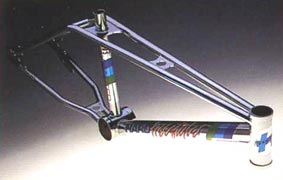
1984 Master frameset.

1984 Sport frameset.
dennyd71, www.youtube.com: master bob explains all about his haro freestyler back in 1984.
Freestylin september 1985: The first thing that attracted us and everyone else we know to this bike was the color. Neon green. You can see this thing comin' for miles - it looks hot. Some of the new colors hittin' the streets nowadays are a little funky, but the Master's neon green hits the spot. It's cool. You guys saw the inspiration for the neon green in the Winter 1984/85 issue. Remember the poster? Who could forget Sigur's shocking green scoot? He'd painted it himself the night before the Huntington Beach contest and didn't even have time to put the stickers on it. Well, that green bike created such a stir and Haro got so many lefters about it that . . . voila, here it is. And the production green is even more fluorescent than Rich's was! Once you stop gawkin' at the color you'll start noticing some of the attention to detail that Haro has put in. Let's start up front, shall we? The front caliper is a Dia-Compe FS 880 set up 'specially for the Potts Mod, which is courtesy of a stock Red Line Forklifter stem and Detangler bolt. Jeez, we just started and we've already mentioned some of the most sano equipment on the market! The forks also have brazed-on cable guides to route your brake cable to the caliper. Something else you'll notice about the forks are the new chromed bolt-on standing plafforms with press-formed holes for better traction. The platform idea is cool - it's easier on your feet than small diameter pegs. The fact that they are removable is sano; you can take 'em off for heavy ramp sessions. The Haro forks are now tapered and swedge-formed - so don't count on tweakin' them too soon. They're strong. Back to the front brake. If you check out the caliper bolt, you'll see that it's recessed into the fork. No more shredded shoes or crunched toes! The headset is a steel Hatta. Haro opted to go with steel for extra strength. Elsewhere up front you'll find the new Haro bars. They're made to Haro specs by an Oriental company called Anlun. Pretty trick stuff, too - the crossbar is "U" shaped and knurled to prevent foot slippage when you're surfin' the parking lots. 100 percent chro-mo, too. Oakley B-2 grips and Dia-Compe Tech 4 levers grace the new bars. Moving towards the mid-section we run into . . . what's this?! These puppies look like . . . Naaah, they can't be! They look just like 180mm Red Line 400 Series Flight cranks, but it says Sugino on'em. Well, guess what? They're one and the same - Sugino actually makes the 400 Series cranks for Red Line so you can count on these being quality three-piece chrome-moly cranks. The crank spindle slips into a Sugino sealed bearing bottom bracket set. Rounding out the package is a 42 tooth Sugino chainring. Ah yes, and attached to the crank arms is a set of MKS Grafight-X pedals - totally primo foot equipment. In the rear we have the most distinctive new feature on the Master - the dropouts and chain stays. There aren't any bolted or welded-on chain stay platforms. That's probably because the chain stays are the platforms - they bow outward to meet "L" shaped dropouts, giving you plenty of room to stand. Everything is integral, giving the bike a clean, business-like look. The rear axle bolts jut out and take up some of the standing space, so the hot tip is to either cut them down to get them completely out of the way, or to buy a couple of axle extensions to give you more room to stand on. A couple of other cool changes have taken place: The customary Haro Master double top tubes have been extended an inch further past the seat tube for more standing room, and the coaster brake bracket, which extends from the dropout, is now attached to the seat stay to keep it out of the way. More sanoness. The back caliper is a Dia-Compe FS 880 with a quick-release feature. The Dia-Compe brake pads work wonders on the Skyway Tuff IIs (with a SunTour coaster brake, of course) that come on the Master. The Dia-Compe brake components are awesome stopping tools. Rubber is supplied by a set of 20x1.75 National Panaracer Freestyle tires, which are rapidly becoming a force in the street tire market. The only drawback to these is that the sidewalls flex a bit more than some of the other freestyle tires - not a big deal. No qualms as far as traction goes - they grip great. But watch for the new Haro tires, which are rumored to be hot. Let's see, what's left? The seating is taken care of by a new Viscount saddle called the Dominator. It has a slightly textured surface that makes it less slippery than your normal plastic seat, which means it'll keep your butt or your foot (whichever happens to be up there) in place. An Anlun lay-back seat post holds up the Dominator. With the lay-back you get plenty of room to move around on the bike, but you can still grab your seat and bars at the same time with one hand - cool. The seat post clamp is a Dia-Compe alloy hinged jobber. That about takes care of the Master's components and detailing. Now you're probably goin', "Man, what's something like this gonna cost?" Don't panic. All this sano stuff retails for about 450 buckos. Not bad at all considering what you get.
Rich Sigur, www.notfreestylin.com: My sponsor would always get mad at me because I had this habit of painting my bike some weird color like neon green or aqua right before a contest. A few weeks later, Haro got so many letters from kids that wanted bike the same color I had that they had to start producing them. Sometimes the best inventions happen by chance. So I guess you can say I'm sort of the catalyst for the color craze that went on during those years.
FST FRAME.
The initials stand for Freestyle, Street and Track
Haro bikes are made in Taiwan.
Haro axle extenders: Brend new Haro aluminium axle extenders. available for either 24TPI or 26TPI axles. Colors are blue, black and silver.
Moving into racing.
BMX Action Bike december 1985: Apart from signing Pete Loncarevich Haro producing new Group One race stem, new hollow G.O. one piece triangular crank and likely to sign a race pro.
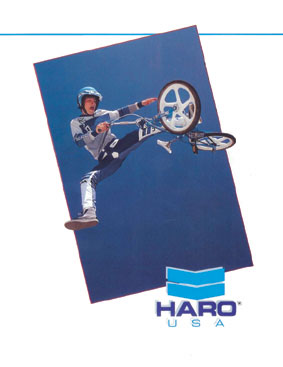
1985 catalog. Ron Wilkerson on the cover.
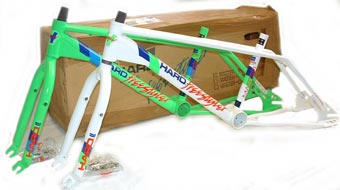
1985 Master. Photo by www.alansbmx.com
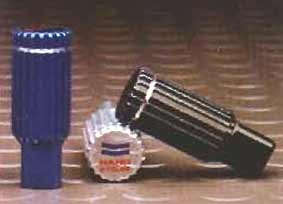
1985 axle extenders.
It was a natural evolution of the business. We were growing but we were still a small company. When I had it we were a little over $ 7 million dollars per year which is not a bad size but in the scope of business it's not a very big business. And you kind of get to that point of if we want to grow the same, we need help. We need distribution, we need money. Business requires money in order to make it to the next level. An opportunity came up with a company called West Coast Cycles at that time, they approached us, and it seemed like the right thing to do. We had been on a roll and it was an opportunity to cash in on the hard work that you have created and that's what we put together. It did help the company get to the next level but it comes with a prize too. When you sell to a bigger company you inherit a lot of the politics and bureaucracy that comes with a big company and as an entrepreneur that's not very fun.
Bob Haro agreed to a five year consulting contract that provided continuing product innovation and a premium image for the brand.
Bicross Magazine, février 1987: Après de nombreux mois de négociations discrètes, Bob Haro a cédé le contrôle de la partie commerciale des scoots Haro à West Coast Cycles et devient désormais la deuxième société au point de vue chiffre et étendue de la gamme après Schwinn (1 million d'exemplaires). Mais Bob Haro reste grand designer et maître chez lui en gardant son autonomie en ce qui concerne le secteur artistique, conceptuel et la sélection du team.
Haro mountain bikes: Explorer line.
HARO GROUP 1.
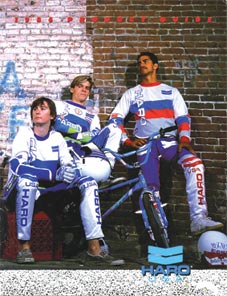
1986 catalog
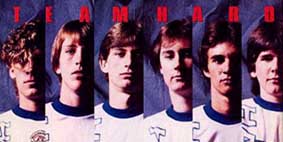
Team HARO 1986
De gauche à droite (from left to right):
Ron Wilkerson - Dennis McCoy - Rick Moliterno - Brian Blyther - Dave Nourie - Joe Johnson.
1987 MASTER.
The same bike Dennis McCoy rode to his overwhelming conquest of the AFA Masters title in 1986. 100% 4130 chromoly frame and fork featuring specialized flatland geometry, quick, precise handling, 74,5° head angle, wrap around head tube gusset, machined BB and head tube, new narrower twin top tube design for increased leg clearance, oversized rear chainstay platforms w/traction pegs, chainstay mounted DiaCompe U-brake, pierced seat tube cable routing, brazed on cable guides, tapered seat stays and forks, wrap around folding fork pegs, serrated dropouts, triphase finish, updated graphics, chromed stays and forks. Available with either Ukai 48 alloy rims or Skyway Tuff 2 mags.
TEAM MASTER.
All the same fine features found on the Master plus the following equipment updates: High pressure tires, hard anodized 48 spoke alloy rims, Suzue sealed bearing hubs. Peregrine 180mm tubular chromoly crank, sealed bearing bottom bracket, Laser Disc sprocket, Shimano PD-MXI5 alloy pedal and Dia-Compe Aerial levers,
SPORT
The same bike Ron Wilkerson chooses for both ramp and flatland. 100% 4130 chromoly frame and fork featuring versatile all-around easy handling. All the same fine frame and fork features also found on our Master with the exception of these differences: two-into-one top tube. 73.5° head angle, longer wheelbase.
TEAM SPORT
All the same fine features found on the Sport plus the same equipment updates offered on the Team Master
FST and FSX:
The most affordable Haro Freestylers. FST with 48 spoke Ukai alloy rims. FSX with Skyway six spoke mags. Both feature Haro FST trimoly frame and full chromoly fork designed for freestyle, street or track with wrap around head tube gusset, twointo-one top tube design, oversized rear chainstay platform brazed on cable guides, bolt-on stationary fork pegs, serrated rear drop outs.
KNEESAVER.
Haro introduced their Kneesaver handlebar.
TRIAL.
Haro trials bike in BMX Action november 1987.
BUSINESS.
Haro business grossed $12,000,000 in 1987.
The same bike Dennis McCoy rode to his overwhelming conquest of the AFA Masters title in 1986. 100% 4130 chromoly frame and fork featuring specialized flatland geometry, quick, precise handling, 74,5° head angle, wrap around head tube gusset, machined BB and head tube, new narrower twin top tube design for increased leg clearance, oversized rear chainstay platforms w/traction pegs, chainstay mounted DiaCompe U-brake, pierced seat tube cable routing, brazed on cable guides, tapered seat stays and forks, wrap around folding fork pegs, serrated dropouts, triphase finish, updated graphics, chromed stays and forks. Available with either Ukai 48 alloy rims or Skyway Tuff 2 mags.
TEAM MASTER.
All the same fine features found on the Master plus the following equipment updates: High pressure tires, hard anodized 48 spoke alloy rims, Suzue sealed bearing hubs. Peregrine 180mm tubular chromoly crank, sealed bearing bottom bracket, Laser Disc sprocket, Shimano PD-MXI5 alloy pedal and Dia-Compe Aerial levers,
SPORT
The same bike Ron Wilkerson chooses for both ramp and flatland. 100% 4130 chromoly frame and fork featuring versatile all-around easy handling. All the same fine frame and fork features also found on our Master with the exception of these differences: two-into-one top tube. 73.5° head angle, longer wheelbase.
TEAM SPORT
All the same fine features found on the Sport plus the same equipment updates offered on the Team Master
FST and FSX:
The most affordable Haro Freestylers. FST with 48 spoke Ukai alloy rims. FSX with Skyway six spoke mags. Both feature Haro FST trimoly frame and full chromoly fork designed for freestyle, street or track with wrap around head tube gusset, twointo-one top tube design, oversized rear chainstay platform brazed on cable guides, bolt-on stationary fork pegs, serrated rear drop outs.
KNEESAVER.
Haro introduced their Kneesaver handlebar.
TRIAL.
Haro trials bike in BMX Action november 1987.
BUSINESS.
Haro business grossed $12,000,000 in 1987.
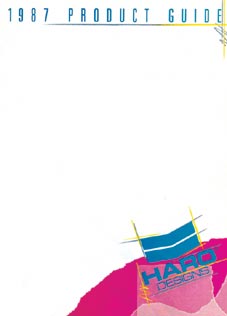
1987 catalog.
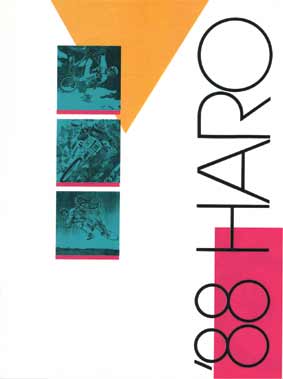
1988 catalog.
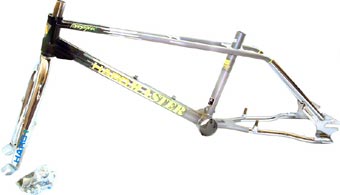
1988 Master. Photo by www.alansbmx.com

1988 Sport. Photo by www.alansbmx.com
Team Haro Freestyle video.
Team Master bike: If you want to know what all freestyle bikes will look like in 1990 take a look at the 1989 Team Master. 100% 4130 chromoly frameset. Twin top tube design. Innovative sprocket guard. Reinforced headtube and bottom bracket. Trick tapered leg forks with close contour, flip-up pegs and thread-in peg bosses. Full cable guides. All new Fusion Twintorc alloy crankset, seatpost clamp and machined aluminum stem by DK. State-of-the-art Pro handlebars and reinforced seatpost. Dia-Compe 883 Aerial braking. ACS Freecoaster. Sealed bearing bottom bracket and high flange hubs 48H Ukai chrome plated alloy rims Surfooted Haro HPM 2.0 high pressure tires. Kashimax seating Brilliant high polish chrome or black.
Bob Haro, www.notfreestylin.com: Bashguard was my idea. At that time, the tricks people were doing, it made sense.
Master bike: Same radical frame, fork and Pro handlebar as the Team Master only spec 'd for the freestyler on a budget. All new Fusion one-piece 175mm chromoly crankset and Twin torc seatpost clamp. Odyssey Gyro/2001/Pitbull/RX3 braking. ACS high flange hubs. Araya 7X 48H alloy rims. Versatile Haro Multisurface tires and chromoly shaft/alloy clamp Pro stem. Brilliant high polish chrome, black or red.
Invert bike: New two-into-one top tube design. 4130 chromoly maintubes and tapered leg forks. Odyssey Gyro/1999/Pitbull/RX3 braking. Durable one-piece crankset and Haro Unidirectional chainring. Sumo 48H alloy rims and Haro Multisurface tires. Brilliant high polish chrome, black or blue.
Shredder bike: Our most affordable full feature freestyler. New two-into-one top tube design. Trick, tapered leg forks. Full cable guides. Haro Team handlebars and chromoly shaft stem. Responsive Odyssey 1999/RX braking front and rear. Sumo 48H alloy rims and Haro Multisurface tires. Tough one-piece crank and chromoly shaft pedals. Durable Suntour freewheel and KMC chain. Teflon lined cables. Brilliant high polish chrome or black.
FUSION.
New line of premium componentry called Fusion. Seat post clamp, stems, cranks.
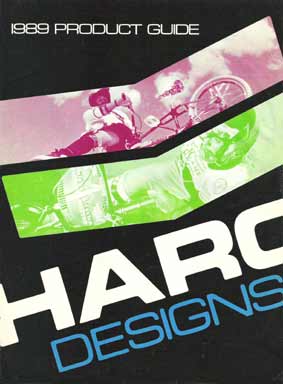
1989 catalog.
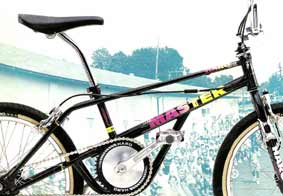
Haro Master 1989.
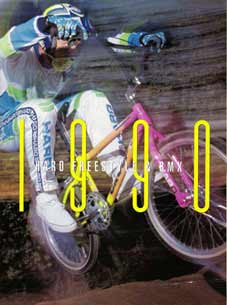
1990 catalog.
Bob Haro left Haro and started a graphic design company that continues to provide leading edge design and marketing services to a wide range of customers.
1991 HARO SPORT.
All new and completely redesigned for 1991. 4130 chromoly mainframe integrated sprocket guard. Ultrathick 3.5mm dropouts. Contouredplastic bashguard for fast, controlled grinds on coping, railings, whatever. Tapered chromoly forks with peg bosses. Brazed-on cable guides, wrap-around head gusset, and new seat tube wing gusset. Available with your choice of alloy 48's or 5-spoke ACS mags.
1991 HARO MASTER.
Reintroducing the bike that launched the sport. That's right, our legendary freestyler is back and radically refined for '91. Classic flatland geometry. Popular twin top tube frame design. New seat tube wing gusset and beefy 3.5mm dropouts for added durability. Integrated thread-in chainstay and fork peg bosses. Wrap-around head gusset and brazed-on cable guides. All 100% chromoly construction. Kneesaver bars. Dia-compe U-braking. Araya 7X 48's. Odyssey Gyro. All new Air Master pegs with replaceable plastic sleeves. Haro's versatile multi-surface tires.
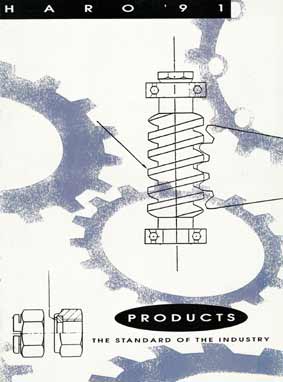
1991 catalog.
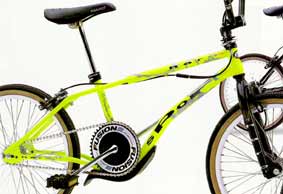
1991 haro Sport.
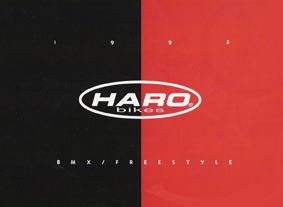
1992 catalog.
All new for 1993. 100% CRMO Megatube construction. Designed to be straight up the absolute ultimate flatland freestyle bike Ever. Classic twin top tube design. Massive double-butted 50mm/2" downtube, Oversized 25.4mm/1 seatpost. Beefy 5mm dropouts Original Master geometry ultimate for flatland Chrome Peregrine 48 wheels. Dia-Compe Nippon 883/AD 990 U-brake. Odyssey Excalibur CRMO cranks and Gyro. Fusion stem, Unitorque seat clamp, DX pedals, pegs, Kashimax saddle and Compact Disc Drive System. Haro Multisurface tires, Kneesaver bars and sticky Kraton grips.
SOLD AGAIN.
In 1993, the company was again sold, this time to a group of investors headed by Haro's Vice President since 1981, Jim Ford. With it's new independence, and Jim leading the company as its President, the company re-established it's focus on Bob's original vision and began a rebuilding process that followed a sharp decline in the BMX market dating back to 1988.

1993 catalog.

1993 Haro Master.
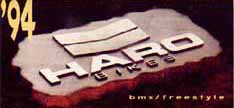
1994 catalog.
The last twin top tube Master.
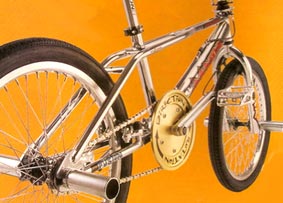
1995 Haro Master.
Test in BMX Plus! october 1996.
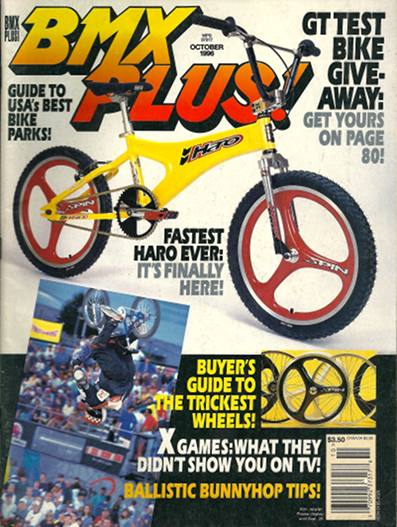
Ride BMX UK december 1997: If you've seen the new 19998 Haro catalogue, you might be asking yourself "Where the hell's the flatland bike ?" Well, not to worry, Haro will be making a 1998 version of the ultra-short Ultra flatland bike, complete with tiny chainwheel, zero-offset forks, 2" alloy flatland pegs, and a very short wheelbase.
Haro's new SR-71 race frame on the cover of BMX Plus! january 1999.

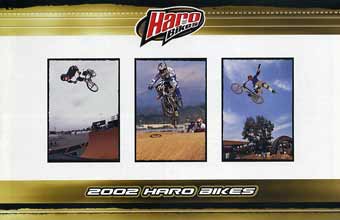
2002 catalog.
harobikes.com, 2004: In celebration of our twenty fifth year, Haro is releasing a very limited edition bike, the Freestyler. Inspired by the bike that started it all, the Freestyler combines today’s technology with a retro look from ‘back in the day’. Only 150 will be produced and each one will be hand-signed by the ‘father of freestyle’ and the founder of the original rider owned company, Bob Haro.
Mike Varley, Transworld BMX november 2003: Its our 25th anniversary and we wanted to do something special to commemorate it. A modern bike with old-school graphics was something that appealed celebrate both the past and the present. The spec part of it was easy; the difficult part was recreating the graphics from scratch, Once we did that, Bob Haro agreed to hand sign each of the top tube decals. These signed decals have his signature protected with an additional clear layer.
Press Release, december 2007:
Nyquist is on board until Dec 2009. That will be the end of his 5-year deal with Haro. At that point he'll decide if he wishes to compete or take on another roll at Haro.
We just resigned Colin Mackay for another two years ensuring that his contract runs through the end of 2009 as well.
We have a two year deal with Dennis Enarson. Completely psyched on this kid. He's local and amazing. Fresh blood. Good stuff.
Ben Hucke. Ben's been instrumental in us getting our shit together with the latest frames and parts that we've put out (and on still coming).
Ben Wallce has been on the UK team for a couple of years. We've switched him over the the US team and will be residing in Greenville during the contest season.
Mike Ishizuka is an amazing rider and does well for us in the local contests scenes and testing all products. He's good for awhile.
(download)
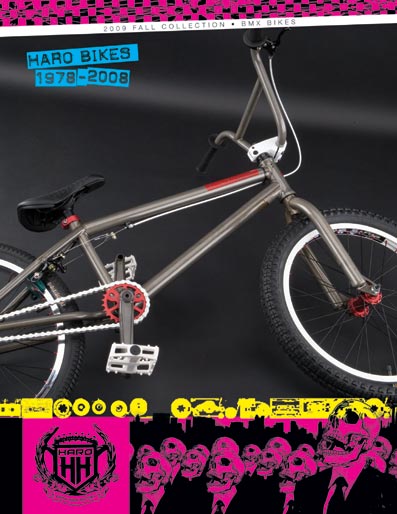
2009 catalog.
Dennis Enarson on the cover. (download)
HARO CONVERT FRAME.
www.harobikes.com, january 2010: Convert is short for convertible, which is exactly what this frame is; removable brake mounts and gyro tabs let you customize your set up, and the assortment of sizes means we have one for midgets and giants alike. The generation 2 version features the new graphics and colors, but still comes complete with BB, headset, and seat post clamp included. Full 4130 Chromoly Frame w/13.75” rear (on both 20.8” and 21”). Double Butted Down Tube. Removable Brake mounts. Removable Rotor Tabs. Removable Cable Stop. 5.2lbs. (with BB, Headset & Clamp). ,Colors: 20.5” BlueIllusion. 20.8” Met. Black. 21” Concrete. 21.5” Matte Black.
SD FRAME.
www.harobikes.com, march 2010: Dennis Enarson signature model. Available in 20.8", 21" and 21.25" top tubes. 75 degree head angle. 11.5 bottom bracket. 13.75 rear center. Fully removable brake mounts/tabs. Integrated seatclamp. CNC machined drop out. 8.6inch (220mm) frame height (from bb center to tt center). 4lb 8oz frame w/o brake mounts/tabs. These frames are expected to arrive mid-april along with the SD Downtown frame, which is a smaller version of the SD Frame available in 20.25" and 20.5". All the specs are the same, other than it’s frame height is an inch lower, for smaller riders. Both frames are available in the 3 colors [grape, acid bath, silver] and both will have a MSRP of $299.00.
HARO FORUM.
Haro Forum Pro Lite bike revue in BMX Plus! august 2010.
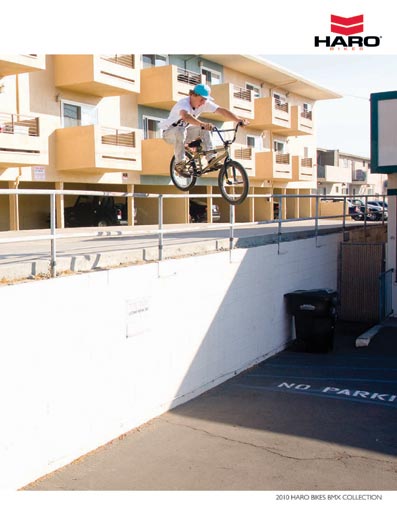
2010 catalog.
Ryan Fudger, bmx.transworld.net, september 2010: The biggest bike company in BMX has a full line of complete bikes ready for people just getting into BMX, those that have been doing it for years, and even ones that are pro-level and ready to ride a major contest out of the box. This is Brand Manager Allan Cooke’s design debut and he’s not only vredesigned each from the tires to the bars, but redefined how Haro looks at it’s completes. Clean aesthetics with simple nomenclature helps you denote exactly what level of bike you want and gone are rigid and specific park, dirt, street bikes…Allan Cooke has designed each bike to ride well on everything—the definition of freestyle. There’s five series of bikes (200, 300, 350, 400, and 500), and they come in varying top tube lengths and colors. In addition, Allan Cooke has made each series available in three different platforms: straight cable with no pegs (200.1, 300.1, etc…), detangler with two pegs (200.2, 300.3, etc…), and detangler with four pegs (200.3, 300.3, etc…). Each platform bumps up the price just $10.
www.harobikes.com: To celebrate the 30th year anniversary of the Haro Freestyler, Haro Bikes has reproduced a limited number of First Generation frame and fork sets for sale to collectors and enthusiasts. The frames have been produced entirely in the United States; using U.S Made 4130 chromoly tubing, and referencing the original Torker produced blue print for authenticity and historical accuracy. Manufactured entirely from 4130 chromoly steel tubing by True Torch in Santa Ana, California, USA. Chrome plated in Garden Grove, California. Screen printed decals color matched and art worked from an archived original set. Authentic knurling to rear dropouts. Manufactured using the original Torker produced technical blue print. Unique Serial number format HB (Haro Bikes) TT (True Torch) 001 - 300 (Production Sequence) AF (Anniversary Freestyler). The frame and fork will be sold for $995 USD on a first come first serve basis.
Brian Blyther. 1985 - 1987
Craig Campbell. In 1981, at age 12, Craig is the first rider outside the States to receive full factory sponsorship from Haro.
Bruce Crisman .... - november 2000: Bruce decided to leave Haro (on good terms) to ride for himself.
Chad DeGroot summer 1997 - ....
Daniel Dhers december 2005: After picking up Australian Colin MacKay, the HARO squad has picked up Daniel Dhers from Venezuela. Quite a few drunken pros were at the Baco-a-go-go jam over Halloween to witness Daniel win the Best Trick contest with a front flip over the decked spine. He's a ripper, just remember the name: Daniel Dhers.
Mike Dominguez. 1984 only
Dennis Enarson 2010
Eddie Fiola By the end of 1982, Bob Morales and Eddie Fiola left team Haro and signed a one year contract with Kuwahara.
Joe Gruttola signs with Haro in 1987
Ron Haro Team Manager (march 1988 - .... )
Josh Harrington february 2001 - ....
Matt Hoffman (march 1988 - ....)&(1990 - 1992) Je suis revenu chez Haro. Ils font de bons vélos et je gagne plus d'argent.
Ben Hucke .... - november 2009: Ben Hucke and Haro have parted ways after many, many years together.
Joe Johnson ....-1987
Tinker Juarez 1982
Todd Lyons. 1994: Todd will ride BMX races, freestyle contests, and MTB races all for Haro Bicycles Corp. - 1997
Dennis McCoy 1985 - march 1988 Haro replaced Dennis with Matt Hoffman.
Marc McGlynn I rode for Haro for two years; 1985 and 1986.
Danny Meng 1991
Dave Mirra august 1994: After looking like a sure thing that Dave Mirra was going to ride for GT, he surprised everyone and signed with Haro. Dave's deal with GT would have required him to live in California and do shows, wich he wasn't too into. The Haro deal allows Dave to live at home in New York and only requires him to go to the BS contests for a reputed $30,000 per year. Haro is also helping Dave get a vert ramp built to practice on, so he should be in top form when he starts competing again.
Rick Moliterno fall 1986: Hutch had financial difficulties and dropped their team. I was lucky enough to land on the great Haro team of the era.
In 1991 I left Haro to start my own bike company Standard Bykes.
Bob Morales quit BMX and got in the newest craze, freestyle. Bob ran into an old riding friend of his, Bob Haro, and made up the original Haro Team. First ever tour of the US in 1981.
By the end of 1982, Bob Morales and Eddie Fiola left team Haro and signed a one year contract with Kuwahara.
Dave Nourie 1985 - 1987
Bill Nitschke 1991
Ryan Nyquist 1997: After losing Todd Lyons to Huffy, Haro has been talking to Northern California superjumper Ryan Nyquist.
Chris Potts 1991
Krt Schmidt 1991
Rich Sigur www.notfreestylin.com: I started riding for Haro in late 1983 on a product sponsorship, the original freestyler frame was the first product they sent me in the mail so an hour later it was bolted together and out to the quarter pipe I went. The Haro was a full inch shorter than the Supergoose(bmx products) bike I had ridden up until this point.
Ben Wallace www.fatbmx.com, december 2008: After making the US Pro team just a year ago Ben Wallace has been dropped by Haro... go figure! He is currently running a frame courtesy of UK Bike Co.
Ron Wilkerson Haro rachete le contrat de Ron chez GT pour un bon paquet de dollars. Team Manager (1985 - 1987)
